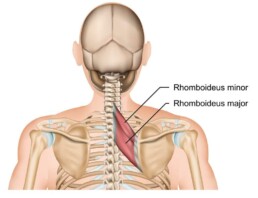If you are feeling pain at the back of your neck between your shoulder blades and your spine, you may be experiencing rhomboid muscle pain. Before we delve into the pain itself, let’s identify the rhomboid muscles.
Your Rhomboid Muscles
Your rhomboid muscles – both major and minor – are located in your upper back where they connect your shoulder blades to your spine. They are part of a group of muscles that form the shoulder girdle which holds your shoulder and shoulder blade stable. Thanks to your rhomboid muscles, you are able to lift and rotate your shoulder blades and pull them back. Rhomboid muscles also help you throw and pull, lift your arm overhead and rotate your torso.

Causes of Rhomboid Pain
Rhomboid pain is generally not serious and can be treated easily with physiotherapy. It may be caused by postures that round your shoulders forward, such as hours spent sitting in front of a computer, or by poor posture. This tires the muscles and they become tight, forming a rhomboid muscle knot in the back. In addition, you may feel rhomboid pain from sleeping on your side, rowing, pushups, throwing motions, pulling motions, working out with weights and injury.
You may feel rhomboid pain after carrying heavy bags or backpacks. In addition, if you have problems with your shoulder joints due to arthritis or myositis, it may affect the surrounding muscles.
Symptoms of Rhomboid Pain
You generally feel rhomboid pain under the neck between the spine and shoulder blades. It may be referred to as shoulder blade pain. You may also feel it at the backs of the shoulders or in the mid-upper back. Additional symptoms can include:
- loss of movement, or difficulty or pain when moving the muscle; pain when breathing;
- a popping or grinding noise when you move the shoulder blade;
- tightness, swelling, and muscle knots around the muscle; and/or
- tenderness in the upper back area.
Treating Rhomboid Muscle Knots
If you are feeling rhomboid pain, begin by treating it as you would any other muscle injury – with RICE, or rest, ice, elevation and compression. Avoid activities that use these muscles; ice the area several times a day for 15 to 20 minutes; wrap the area with a compression bandage; and when lying down or sleeping, keep your chest and shoulders elevated with pillows. You can also use topical pain relievers, such as Voltaren, or essential oils to reduce pain.
After a few days of icing the area, you can apply heat with a warm compress or a heating pad for 15 to 20 minutes at a time; you may wish to alternate heat and ice.
If you’ve taken these steps and haven’t found relief, it’s time to see a physiotherapist. They can recommend a course of exercise that will help the injured area heal. These exercises may include stretching your chest to reduce the strain being placed on the muscles and those that strengthen your upper back.

You can also try a self massage: Take a tennis ball and place it between your upper back and the wall. Lean into it until you find the sore spot; then, gently make small circles with the ball. You can also lie on the floor and roll your shoulders over a foam roller to loosen and massage the muscles. Your physiotherapist will suggest other exercises targeted to your injury, depending on its severity.
It will take a bit of time to recover from rhomboid muscle pain, depending on how severely you have strained the muscles. Mild strains generally heal within three weeks, while more severe strains may take several months to heal.
Preventing Rhomboid Pain
Once your rhomboid pain is going, going, gone, keep it at bay by using a number of preventive measures:
- Always warm up before a workout and cool down afterward;
- Avoid lifting heavy objects, and use proper form when you do;
- Carry heavy backpacks on both shoulders, not one;
- Exercise and stretch regularly to stay in shape;
- Maintain a healthy weight;
- Practise proper technique when playing sports;
- Practise good posture while sitting, standing and walking;
- Take a break from exercise and activities when you feel sore or tired;
- Take frequent breaks to move around, walk, and stretch during periods of extended sitting; and
- Use protective equipment for sports and work.
Once you’re back to your old self, you can also consider working with your physiotherapist on an exercise program to ensure that you avoid imbalances in your body.
